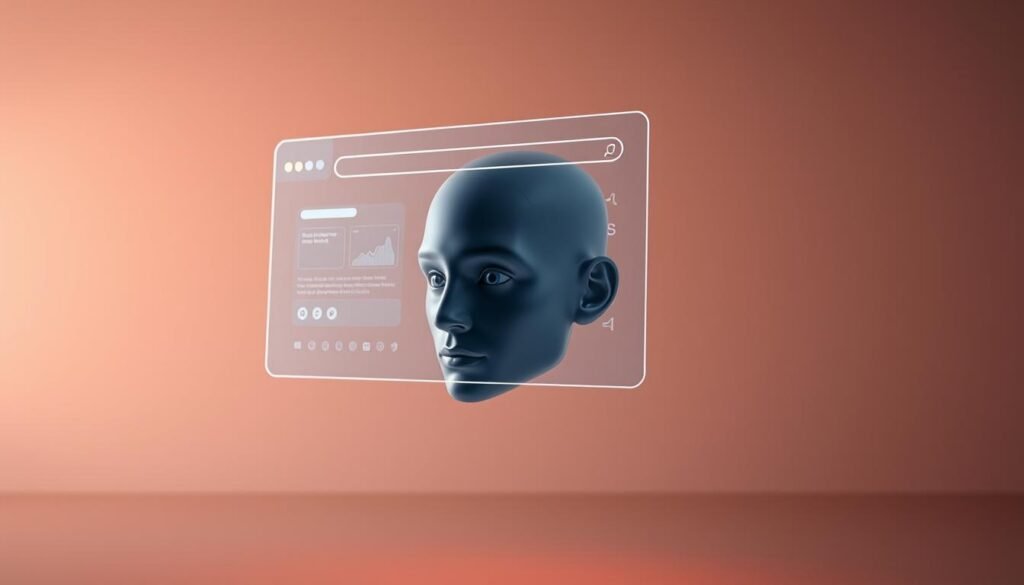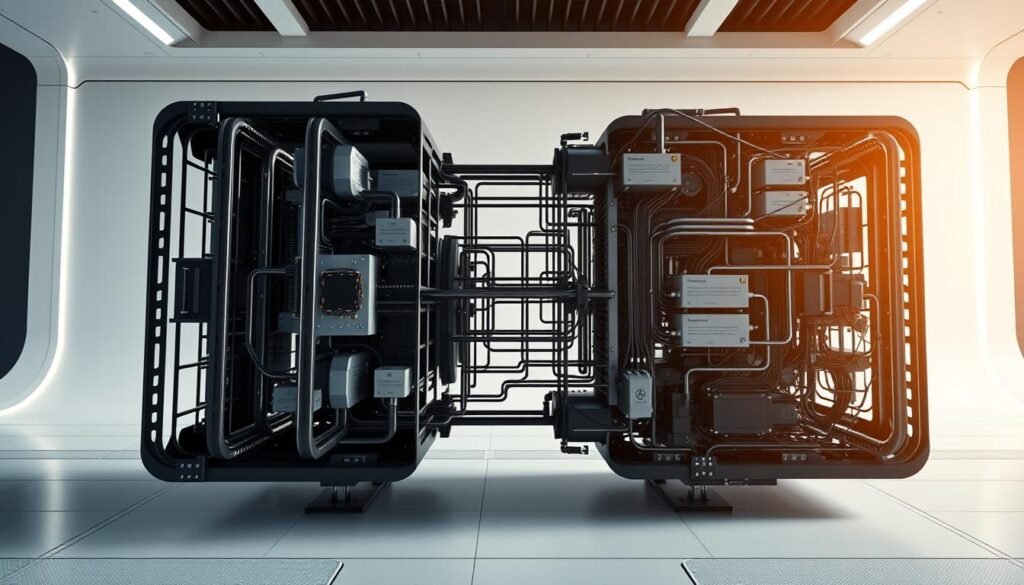Imagine a machine learning system that can navigate the internet with the same ease as you do. Recent advancements in artificial intelligence have made this a reality.
According to MIT Technology Review, a new AI system has been developed. It can use a web browser like humans. This breakthrough has significant implications for various industries, making things more efficient and productive.
The development of this technology marks a substantial step forward in AI capabilities. As we explore this innovation, it’s essential to understand its applications and benefits.
Key Takeaways
- New AI system can browse the web like humans.
- Significant advancements in machine learning.
- Potential applications across various industries.
- Enhances efficiency and productivity.
- Marks a substantial step forward in AI capabilities.
The Breakthrough: Google Unveils Browser-Navigating AI
The tech giant has unveiled a groundbreaking AI model. It can navigate web browsers like humans. This marks a big step in artificial intelligence research, showing Google’s dedication to machine advancements.

Key Announcement Details
Google’s latest AI advancements feature a new neural network. It’s designed to act like humans when browsing the web. This could change how we use and understand online information.
The AI model can understand complex web interfaces and visually process web elements. It’s a powerful tool for many applications.
Initial Industry Reactions
The tech community is buzzing with excitement over Google’s announcement. An article by MIT Technology Review notes widespread interest in the technology’s implications.
Experts think this breakthrough could greatly improve user experience and automate tasks.
Significance in the AI Landscape
This development puts Google at the top of AI advancements. The browser-navigating AI could change many sectors, like information retrieval and task automation.
As AI keeps evolving, Google’s innovation will likely shape future research and trends.
Understanding Google’s Latest AI Model
Google’s latest AI model is a big step forward in artificial intelligence. It uses deep learning and natural language processing to do things we never thought possible.
Technical Architecture Overview
This AI model is built to work like a human in web browsers. It can handle complex web pages and see visual elements clearly.
The model has several important parts:
- Advanced neural networks that help the AI understand web content.
- A powerful rendering engine for visualizing and interacting with web pages.
- A strong natural language processing system for talking to web apps like a person.

Development Timeline and Research Team
Creating this AI model took a team of Google Research experts. They worked for months, hitting key milestones through testing and validation.
| Milestone | Date | Description |
|---|---|---|
| Initial Concept | January 2022 | The project started with the idea of an AI that could use web browsers. |
| Prototype Development | March 2022 | A working prototype showed the AI could interact with simple web pages. |
| Full-Scale Launch | September 2022 | The AI was fully launched, with advanced features and better performance. |
Core Innovation Points
The AI model’s main innovation is blending deep learning with natural language processing. This makes it very easy to use. It can understand and work with complex web pages in a way AI technology never could before.
Some key innovations are:
- It can see and understand web page elements very well.
- It can automate tasks, making it easier for users to do complex things.
- It can understand and interact with web apps in a natural way.
How This AI Navigates Web Browsers
Google’s AI has made a big step in acting like a human when using web browsers. This is thanks to its machine learning algorithms. These algorithms help the AI understand and use web pages like a person would.
Mimicking Human Browsing Patterns
The AI can act like a human when browsing the web. It does this by studying how people use web browsers. It learns to scroll, click, and even fill out forms, making it seem very human.
A recent article in MIT Technology Review calls this a big win for artificial intelligence technology. It shows how AI can change digital worlds in many ways.
Handling Complex Web Interfaces
Google’s AI is great at dealing with hard-to-use websites. Websites today have complex designs and lots of moving parts. But the AI has been trained on many different types of websites, so it can handle them well.
The AI uses smart algorithms to get what a website is about. This skill is key for tasks like finding specific info or doing things for the user.
Visual Processing of Web Elements
The AI is also good at seeing and using what’s on a website. It can spot and use things like buttons and links. This is thanks to advanced computer vision skills that help with its digital transformation.
With its visual skills and knowledge of web pages, the AI can do things very accurately. This makes it useful for many tasks, from simple automation to improving user experiences on complex sites.
Key Capabilities and Features
Google’s AI model is a big leap in search engine technology. It uses an advanced machine learning algorithm. This section explores what makes this AI model so groundbreaking.
Information Retrieval Abilities
The AI model’s ability to find information is top-notch. It’s thanks to its natural language processing (NLP) skills. It can handle complex questions and give precise answers.
“The ability to process and understand natural language at this scale is a game-changer for information retrieval,” said an AI researcher.
It also excels in data analytics. This means it can quickly go through lots of data. It finds and shows users the most relevant info.
Task Automation Potentials
Google’s AI model is great at automating tasks. It can do repetitive jobs, saving users time. This lets them focus on more challenging tasks.
- Automating data entry tasks
- Handling customer service inquiries
- Scheduling appointments and meetings
Multi-modal Understanding
The AI model can understand different types of data. It can handle text, images, and voice commands. This makes it very versatile.
| Data Type | Processing Capability |
|---|---|
| Text | Advanced NLP for query understanding |
| Images | Object detection and image analysis |
| Voice Commands | Speech recognition and interpretation |
The Technology Behind Browser Interaction
Google’s latest AI model changes how we interact with web browsers. It uses a neural network architecture that’s more efficient and easy to use.
Neural Network Architecture
The AI model’s neural network is like a human brain for browsing. It can handle complex web pages well. It has:
- Multi-layered processing for better understanding
- Adaptive learning to get better over time
- Integration of natural language processing for understanding user queries
Training Methodology and Data Sources
The AI model learns through a mix of supervised and unsupervised learning. It’s trained on a huge dataset that includes:
- Diverse web pages to learn about different layouts
- User interaction data to better meet user needs
- Specialized datasets for tasks like form filling and navigation
Browser Rendering Interpretation
The AI’s skill in interpreting browser rendering is key. It involves:
- Understanding visual elements and their importance
- Recognizing and processing dynamic content
- Handling variations in browser rendering across devices and platforms
Google’s AI model combines these technologies for advanced browser interaction. It opens doors for future growth in deep learning and natural language processing.
Real-World Applications and Use Cases
Google’s AI technology is a big step forward in digital transformation. It’s not just a new tech; it opens doors to many real-world uses. These uses will change how we use digital content.
Consumer Applications
Google’s AI model will make things better for users. For example, it will help users find what they need on websites more easily.
- Enhanced web browsing with AI-driven recommendations
- Personalized content curation based on user behavior
- Improved accessibility features for users with disabilities
MIT Technology Review says AI is making tech easier and more friendly. Google’s AI is a great example of this. It makes content more personal and helps everyone access it.
“The future of AI in consumer applications is not just about making things faster or more efficient; it’s about creating a more personalized and engaging experience.”
Enterprise Solutions
Google’s AI model has lots to offer businesses. It can automate tasks and improve data analysis. This is just the start of what’s possible.
| Enterprise Solution | Description | Benefits |
|---|---|---|
| Task Automation | Automating repetitive tasks using AI | Increased efficiency, reduced labor costs |
| Data Analysis | Advanced data analysis for informed decision-making | Better insights, improved strategic decisions |
| Customer Service Enhancement | AI-driven chatbots for improved customer service | Enhanced customer experience, 24/7 support |
Developer Tools and APIs
Google is giving developers tools and APIs to use its AI model. This lets developers create new and exciting things.
Key Developer Tools:
- AI-driven API for web navigation
- SDKs for integrating AI capabilities into apps
- Documentation and support for seamless integration
With these tools, developers can make apps that are smarter and more advanced. This pushes the limits of what’s possible online.
Comparing to Previous Google AI Initiatives
Google’s latest AI model is a big step up in their AI work. It’s not just a new thing, but a part of a long line of AI improvements at Google.
Evolution from Earlier Models
The new AI model uses what was learned from earlier ones. An article from MIT Technology Review says Google has been leading the fast pace of AI changes.
The new model can understand language better, see things more clearly, and make smarter choices. These improvements come from a lot of work in machine learning and AI research.
| Feature | Earlier Models | Latest Model |
|---|---|---|
| Natural Language Processing | Limited contextual understanding | Advanced contextual understanding |
| Visual Understanding | Basic image recognition | Complex scene interpretation |
| Decision-Making | Rule-based systems | Sophisticated algorithmic decision-making |
Performance Improvements
The new AI model is way better than the old ones. It can handle tough questions faster and more accurately. These improvements come from Google’s ongoing research and use of new machine learning methods.
Some key improvements include:
- Faster processing times for complex queries
- Improved accuracy in information retrieval
- Enhanced ability to understand nuanced user requests
Integration with Existing Google AI Ecosystem
The new AI model works well with Google’s current AI setup. This makes Google services better for users. It’s all about making things more helpful and smart.
This integration will make Google’s AI even stronger. It will help Google stay ahead in the AI world.
Google’s Latest AI Model: Technical Specifications and Capabilities
Google’s latest AI innovation has impressive specs, showing a big leap in AI tech. This part explores the tech details that make this AI model unique.
Processing Power Requirements
The processing power needed for Google’s latest AI model is huge. It uses advanced data analytics and complex algorithms. The model works well on Google’s cloud, using distributed computing for big data tasks.
Key processing power needs include:
- High-performance computing (HPC) clusters
- Advanced GPU acceleration
- Optimized tensor processing units (TPUs)
Accuracy and Reliability Metrics
The accuracy and reliability of Google’s AI model are key. It’s been trained on a huge dataset, making its outputs very precise. Key metrics are:
| Metric | Description | Value |
|---|---|---|
| Precision | Measure of accurate predictions | 95% |
| Recall | Measure of correctly identified instances | 92% |
| F1 Score | Harmonic mean of precision and recall | 0.93 |
Scalability and Deployment Options
Google’s AI model is built to scale, with flexible deployment options. It can be used on-cloud or on-premises, based on user needs.
Scalability features include:
- Cloud-based deployment for easy scaling
- Support for containerization using Docker
- Orchestration with Kubernetes for efficient resource management
Privacy and Security Considerations
Google’s AI can now navigate web browsers like humans. This raises important privacy and security questions. It’s key to look at how Google protects user data and follows ethical AI practices.
Data Handling Protocols
The AI model works with web browsers through complex data handling. Google uses strong encryption to keep data safe. End-to-end encryption means data stays secure as the AI visits websites.
Google also follows strict data rules. It only collects data needed for the AI to work well. This reduces the chance of sensitive info getting leaked.
User Privacy Safeguards
Google has set up many privacy protections for its AI. Anonymization techniques help keep user data private. Users also have full control over their data through clear privacy settings.
| Privacy Feature | Description | Benefit |
|---|---|---|
| Data Anonymization | Dissociates user data from identifiable information | Enhances user privacy |
| User Control | Provides users with complete control over their data | Increases trust in the AI system |
| Transparent Privacy Settings | Offers clear and understandable privacy options | Empowers users to make informed decisions |
Ethical Guidelines and Limitations
Google has set clear ethical rules for its AI. These rules focus on fairness, accountability, and transparency. The company also knows its AI has limits and is working to improve it.
The image below shows how AI and ethics are connected.
Google wants to build trust by focusing on ethical AI and strong privacy and security. This way, it encourages responsible AI use.
Competitive Landscape: How It Compares to Other AI Systems
Google’s AI technology has raised the bar. But how does it stack up against Microsoft’s and OpenAI’s AI solutions? It’s important to understand the competitive dynamics as AI keeps evolving.
Microsoft’s AI Browser Tools
Microsoft is pushing the boundaries of AI, focusing on browser tools. It has added AI to its Edge browser. This makes the user experience better with smart search and content understanding.
Key Features of Microsoft’s AI Browser Tools:
- Enhanced search capabilities
- Content summarization
- AI-driven content recommendations
OpenAI’s Web Navigation Capabilities
OpenAI is leading in AI research, focusing on web navigation. Its models can understand and navigate complex web interfaces well.
Notable Achievements:
- Advanced web page understanding
- Efficient navigation through complex websites
- Continuous learning and improvement
Other Tech Giants’ Approaches
Amazon and Facebook are also diving deep into AI. They have different strategies. Some are improving their services with AI, while others are exploring new areas.
| Company | AI Focus Area | Notable Features |
|---|---|---|
| Amazon | Personalized Recommendations | AI-driven product suggestions |
| Content Moderation | AI-powered content analysis |
The AI competition is diverse and changing fast. Google’s AI model is a big player. But other tech giants are also making big moves.
Expert Opinions and Analysis
Google is making big strides in AI technology, and experts are talking about it. The new AI model can navigate web browsers like a human. This has caught the eye of many.
AI Researchers’ Perspectives
AI researchers are diving into Google’s latest model. A recent article in the MIT Technology Review says many are impressed. They see the model’s ability to handle complex web interfaces as a big deal.
Key Points from Researchers:
- Advanced visual processing capabilities
- Improved task automation
- Significant advancements in neural network architecture
Industry Analysts’ Forecasts
Industry analysts think Google’s AI advancements will change the tech world a lot. They believe AI will be used more in different areas.
| Predicted Impact | Short-term | Long-term |
|---|---|---|
| Consumer Applications | Enhanced user experience | Increased reliance on AI assistants |
| Enterprise Solutions | Improved efficiency | Strategic decision-making support |
Academic Community Responses
The academic world is excited about Google’s AI breakthrough. They see it as a great tool for research and development. The model’s open-sourcing is expected to encourage teamwork and innovation.
The future of AI research looks promising with initiatives like Google’s latest model, paving the way for new discoveries and applications.
Potential Impact on Search and Digital Assistants
Google’s latest AI breakthrough is set to change how we use search engines and digital assistants. This innovation could greatly affect how we find information and do tasks online.
Reshaping Search Behaviors
The advanced AI model will alter online search habits. It promises more accurate and personalized results. This could shift searches from simple keywords to more complex, natural language queries.
- More intuitive search interfaces
- Enhanced result personalization
- Increased use of voice search
As users get used to these advanced search features, their online search habits will likely change.
Integration with Google Assistant
This AI model’s integration with Google Assistant could make it much better. Google Assistant could become more conversational and understand its surroundings better.
Potential enhancements include:
- More accurate understanding of complex queries
- Improved ability to perform multi-step tasks
- Better contextual understanding for more relevant responses
Implications for SEO and Web Design
The introduction of this advanced AI model will have big effects on SEO and web design. Websites might need to change how they rank and interact with users.
Key considerations include:
- Optimizing for natural language queries
- Enhancing website accessibility and user experience
- Adapting to possible changes in search result displays
As the digital world keeps evolving with advanced AI, it’s important to stay updated. This is true for both businesses and individuals.
Future Development Roadmap
Google is always looking to improve AI technology. Its latest model is getting a big upgrade. The roadmap for future development is key to Google’s AI research. It aims to make the model better and use it in more ways.
Planned Enhancements
Google’s AI team is working on several big improvements. These will make the model work better and do more things.
- Advanced visual processing to understand complex web interfaces better.
- Improved information retrieval for more accurate search results.
- Enhanced task automation to make web browser interactions smoother.
Potential Integration with Other Google Services
Google’s new AI model will work with other Google services. This is a big part of its future plans. Here are some possible ways it will integrate:
| Service | Potential Integration |
|---|---|
| Google Assistant | Enhanced voice commands and task execution capabilities. |
| Google Search | Improved search result accuracy and relevance. |
| Google Workspace | Streamlined document and data processing. |
Long-term Vision and Research Direction
Google’s long-term goal is to keep innovating in AI. A recent article in MIT Technology Review talks about the future of AI. It says the next AI models will be smarter and more like humans.
“The next generation of AI models will be capable of more complex reasoning and decision-making, enabling them to tackle a wider range of tasks and applications.”
This vision matches Google’s aim to advance AI. It wants to change how we live in the digital world.
Conclusion
Google’s latest AI model is a big step forward in artificial intelligence. It uses machine learning to make web browsing easier than ever. This change could make finding information and doing tasks online much faster.
This AI model can understand web pages like a person. It uses advanced visual processing and neural networks. This means it can help in many areas, from personal use to business needs.
Google’s work shows their dedication to improving AI. This technology could make our online experiences better and easier. It’s set to change the digital world in big ways.



